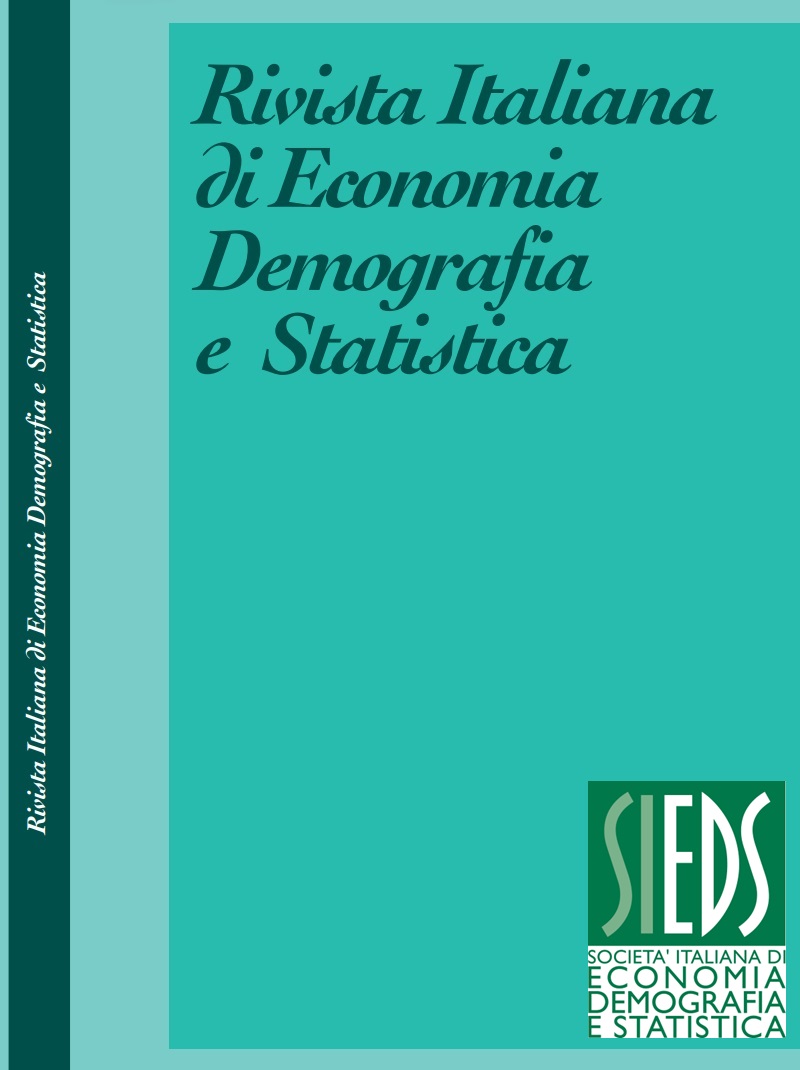Measurement of absolute poverty in Italy: an empirical analysis
DOI:
https://doi.org/10.71014/sieds.v79i3.357Abstract
Absolute poverty is a socio-economic measure based on the monetary evaluation of a basket of goods and services, considered essential to avoid serious forms of social exclusion. Absolute poverty has been estimated in Italy since 2005 by the Italian Institute of Statistics, with reference to household consumption, using data from the Household Budget Survey (HBS), comparing the expenditure of Italian households with the absolute poverty thresholds. The reference unit is the household, considered in relation to the characteristics of the individual components, their specific needs (nutritional, for instance) and any scale or forms of savings that can be achieved when the family composition varies. Essential needs have been identified in adequate nutrition, in the availability of a dwelling - equipped with necessary goods and services according to the needs of the household - and in the minimum necessary to dress, communicate, get informed, move in the territory, educate and maintain good health. Consequently, the basket is composed of three macro components - food, housing, residual - whose monetary valuation was not carried out at the absolute minimum price, but at the minimum price accessible to all households taking into account the different distribution channels. The monetary value of the total basket was obtained from direct sum of the various components and corresponds to the household absolute poverty threshold. Monthly expenditure used to purchase goods and services exclusively devoted to meet the households needs (including presents purchased), is compared with the value of the poverty threshold, in order to classify a household as absolutely poor or non-poor. After a methodological revision in 2022, the poverty threshold is now defined by the combination of the household type, the region and the municipality of residence. As a consequence, it is possible to identify as many absolute poverty lines as many combinations exist between the elements mentioned before. The methodology revision has allowed the release of more punctual data, capturing the heterogeneity of the expenditure for the different household types in the different areas/territories of the Country. Then, in this paper we briefly show the main changes in the methodology for the measurement of absolute poverty and we present some descriptive analysis on the poverty thresholds calculated for the period of 2014-2022.
References
APREA G., BATTLES S., GALLO G., PASSERI S., PALOMBI M., RAITANO M., ROMANO E., ZOPPOLI P. 2023. Measuring poverty in Italy: how the AD-HBS dataset can offer new insights. Ministry of Economy and Finance, Department of the Treasury.
BEYCAN T. 2023. Basic Needs, Absolute Poverty: Measuring Poverty in Developing Countries. In Encyclopedia of Quality of Life and Well-Being Research, Cham: Springer International Publishing, pp. 1-7. DOI: https://doi.org/10.1007/978-3-319-69909-7_104683-2
CARBONARO, G. 1993. On defining and measuring poverty, International Review of Sociology, Vol. 4, Nos.1-2, pp. 8-36. DOI: https://doi.org/10.1080/03906701.1993.9971132
CHEN S., RAVALLION M. 2007. Absolute poverty measures for the developing world, 1981–2004, Proceedings of the National Academy of Sciences, Vol. 104, No. 43, pp.16757-16762. DOI: https://doi.org/10.1073/pnas.0702930104
COMMISSIONE DI INDAGINE SULLA POVERTA’ E SULL’EMARGINAZIONE. 1998. La povertà in Italia 1997. Roma: Presidenza del Consiglio dei Ministri, Dipartimento per l’informazione e l’editoria.
CUTILLO A., RAITANO M., SICILIANI I. 2022. Income-Based and Consumption-Based Measurement of Absolute Poverty: Insights from Italy, Social Indicators Research, Vol. 161, No. 2, pp. 689-710. DOI: https://doi.org/10.1007/s11205-020-02386-9
FREGUJA C., PANNUZI N. 2007. La povertà in Italia: che cosa sappiamo dalle varie fonti? In A. BRANDOLINI e C. SARACENO (a cura), Povertà e benessere. Una geografia delle disuguaglianze in Italia, Bologna: il Mulino, pp. 23-60
ISTAT, 2009. La misura della povertà assoluta. Metodi e norme n. 39. Istat.
KLASEN S. 2016. Levels and Trends in Absolute Poverty in the World: What we know and what we don't. In Absolute poverty and global justice, Routledge, pp. 21-36.
LADERCHI C. R., SAITH R., STEWART F. 2003. Does it matter that we do not agree on the definition of poverty? A comparison of four approaches. Oxford development studies, Vol. 31, No.3, pp. 243-274. DOI: https://doi.org/10.1080/1360081032000111698
RAVALLION M. 2016. The economics of poverty: History, measurement, and policy. Oxford University Press. DOI: https://doi.org/10.1093/acprof:oso/9780190212766.001.0001
RINGEN, S. 1988. Direct and indirect measures of poverty, Journal of social policy, Vol. 17, No. 3, pp. 351-365. DOI: https://doi.org/10.1017/S0047279400016858
SIMLER K. R., ARNDT C. 2007. Poverty comparisons with absolute poverty lines estimated from survey data, Review of Income and Wealth, Vol. 53, No. 2, pp. 275-294. DOI: https://doi.org/10.1111/j.1475-4991.2007.00228.x
SON H. H., KAKWANI N. 2009. Measuring the impact of price changes on poverty. The Journal of Economic Inequality, Vol. 7, pp. 395-410. DOI: https://doi.org/10.1007/s10888-008-9093-0
Downloads
Published
Issue
Section
License
Copyright (c) 2025 Valeria de Martino, Livia Celardo

This work is licensed under a Creative Commons Attribution 4.0 International License.



